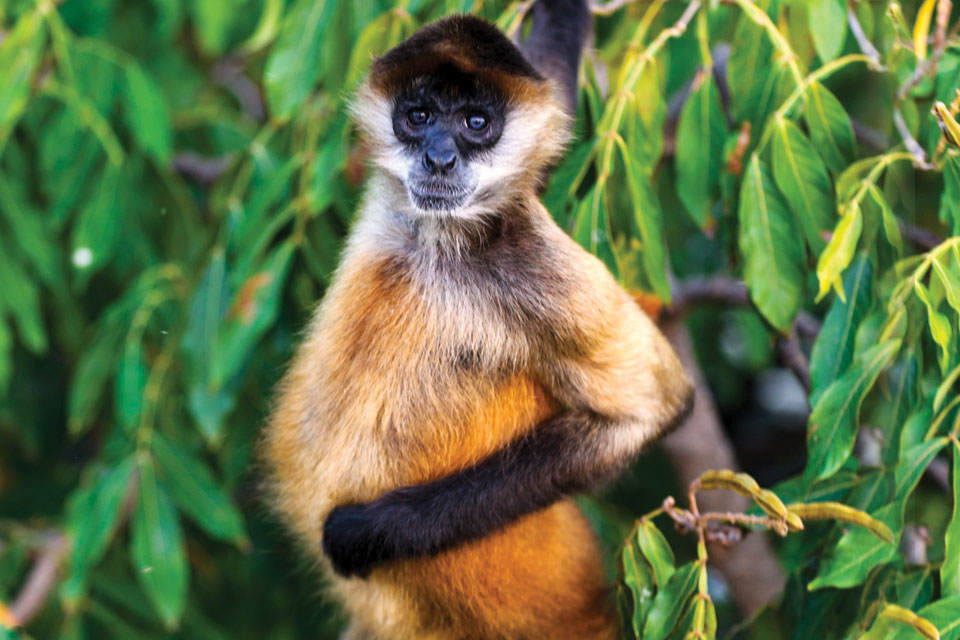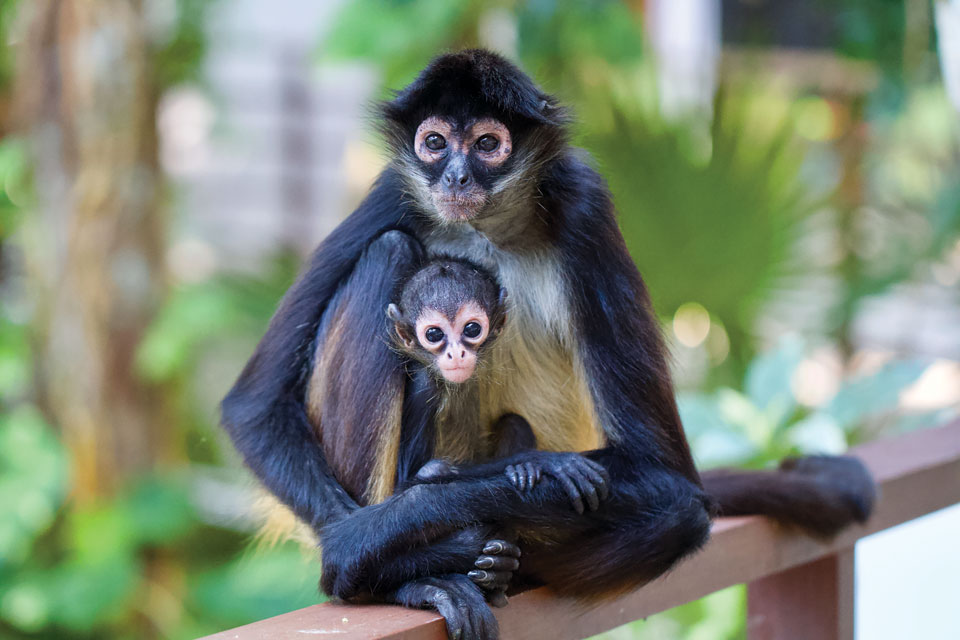
Geoffroy’s spider monkeys, also called black-headed spider monkeys, are native to Central and South America. Their range includes Mexico, Belize, Costa Rica, El Salvador, Guatemala, Honduras, Nicaragua, and Panama. The New World monkey lives in the upper levels of the forest canopy in a variety of forestlands, including rainforests.
The Black-headed spider monkeys are classified as Critically Endangered, and their numbers are decreasing. This primate belongs to the group of New World monkeys and the species is composed of two sup-species, differing in their color pattern: Brown-headed spider monkeys, which exhibit brownish-black overall fur and a brown head, and Colombian spider monkeys that are totally black, displaying only a few white patches on their chins. The Black-headed spider monkeys are excellent climbers and have a strong grip due to lacking a thumb.
The Black-headed spider monkeys are very social animals. These primates are known to form large groups of from 20 – 100 monkeys, composed of multiple males and females. When feeding, these groups split into smaller sub-groups. Spending the majority of their time in trees, they rarely descend to the ground. When travelling among trees, they swing on all four legs. When moving along branches, they usually walk in an upright position. These animals are capable of taking long leaps of up to 30 ft. when moving between branches. They are most active during the daylight hours spending this time in the forest canopy foraging for food. Mornings are spent feeding themselves, while afternoons are reserved for rest.
The Black-headed spider monkeys are threatened by deforestation, which negatively affects the overall population of this species. Although some populations still inhabit partially logged forests, hardly any group can be found in areas where the rainforest habitat is totally wiped out. Additionally, localized threats include hunting for food.



The Geoffroy’s spider monkey is one of the largest of the New World monkeys, with the male of the species being slightly larger than his female counterpart. The tails of both males and females are longer than their respective bodies, and their arms are longer than their legs. Head-to-body length in male Geoffroy’s spider monkeys ranges from 1.3 to 2 ft., with a weight between 16 and 20 lbs. Head-to-body length in female Geoffroy’s spider monkeys ranges from 1 to 1.5 ft, with a weight between 13 and 18 lbs. The maximum life span in the wild is unknown. In captivity, the Geoffroy’s spider monkey can live from 33 to 47 years.
As their name implies, the hands and feet of the Geoffroy’s spider monkeys are black. Their fur coats vary in color from light buff to reddish-brown or black. Infants are born black, but their fur lightens in color during their first five months of life.
Geoffroy’s spider monkeys have a penchant for ripe and fleshy fruits; in fact, 80 percent of their diet is comprised of various fruits. Their color-vision eyesight allows them to easily select their favorites. They supplement their diet with leaves, flowers, buds, and occasionally bark, nuts, seeds, insects, spiders, and eggs. Young leaves provide the protein that can be lacking in fruit. Besides providing much of the monkey’s nutritional needs, fruits and leaves provide much of their water requirements as well. Like other spider monkeys, Geoffroy’s spider monkeys will drink water from tree holes and from water gathered on leaves; unlike other spider monkeys, however, they will also drink water from land sources.
Geoffroy’s monkeys use a variety of sounds and postures to communicate. Barks are alarm calls used to signify a threat, while whinnies (which consist of between two and 12 quick increases and decreases in pitch) and screams are distress calls often made when separated from one another. Whinnies are perhaps the most versatile vocalization, also used to alert others in the group to a food source, to maintain contact with one another while foraging, and to call out at dawn and dusk. Because each monkey emits a unique sound, other monkeys in the group are able to recognize one another through vocal communication.
Postures include a curled tail or arched back, used as a threat display towards other spider monkeys. A head shake is used either as a threat or an invitation to play. Shaking branches or swaying arms are used to warn the group of impending danger. As an example, when approached by humans, Geoffroy’s spider monkeys bark, throw branches, shake tree limbs, and jump up and down.
Spider monkeys are considered to be the third most intelligent nonhuman primate, behind only orangutans and chimpanzees and ahead of gorillas and all other monkeys. Their mental capacity is thought to be an adaptation to their fruit-based diets, which require that they identify and memorize many different fruits from a variety of fruit trees, and the location of these trees.
The spider monkey has no specific breeding season. After selecting her partner, the couple is given its privacy. Copulation occurs with each in a sitting position facing the same direction, with the male seated behind. He wraps his arms around the female’s chest and his legs around her waist in an embrace that lasts from 8 to 22 minutes. Females give birth to a single infant every two to four years, after a gestation period of seven to eight months. Babies are carried on their mothers’ chests for the first two months, and then begin riding on their mothers’ backs. They remain dependent on their mothers for three years.
As the youngsters begin moving independently through the forest canopy, they are often given a bit of assistance from adults in the group. Because the youngsters’ limbs aren’t yet long enough to propel them from tree to tree, an adult will stretch her body between two trees, forming a bridge so that these young spider monkeys can cross.
Females reach sexual maturity at four years at which time they typically leave their birth group and find another group to join. Males reach sexual maturity at five years and remain in their birth group.
Spider monkeys play an important role as seed dispersers. Foraging activity also stimulates the growth of trees, since extra foliage, branches, and other organic matter that is dropped from the canopy provides nutrients to the soil.
Geoffroy’s spider monkeys are classified as Endangered by the International Union of Conservation of Plan®, a cooperative breeding program between zoos working together to ensure the survival of the species. However, additional conservation efforts are needed within the monkeys’ natural habitat to ensure the species’ long-term survival in the wild.
